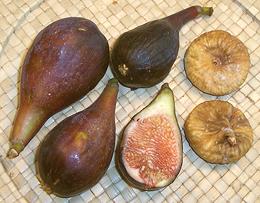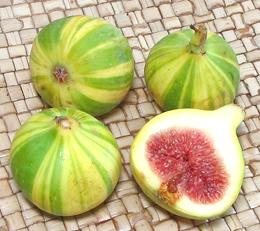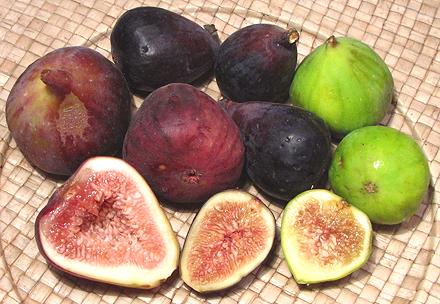
Dried Shirazi Figs (see text)

Fresh California Mission Figs, and imported Dried Figs
from Turkey

Fresh California Tiger Figs, a "decorator" version seen
here in Los Angeles since 2017. The taste is quite similar to the
green Calimyrna figs.
The top photo to the left is of dried Shirazi Figs, also known as Persian Figs and Shirazi Anjeer. They are very small at 1 inch diameter and a little less than 1/4 ounce. They are less sweet than the larger figs. Supposedly they are gathered wild in the mountains of Iran, but since Iranian imports are not legal in the U.S. at this time, that is not something I can confirm - they either are from elsewhere or have been "laundered" through a third country.
The most important Fig producing areas are Turkey, Egypt, Algeria, Iran and Morocco. Fresh figs are extremely perishable so about 90% of the crop is sold dried. Fresh figs are easily available only around the regions where they are grown.
California produces nearly the entire U.S. crop, though it's only about
10% as large as Turkish crop. The major varieties are Black Mission (black
or purple skin, pink inside, fresh or dried), Kadota (greenish yellow
skin, purple inside, used for canned figs), Calimyrna (greenish yellow
skin, pinkish brown inside) which is the favorite drying variety, Brown
Turkey (purplish skin, pink inside) and Adriatic (light green skin, pale
pink inside) from which fig bars and paste are made.
Buying:
Here in Southern California fresh black and green figs are easily available in the multi-ethnic produce stores, when in season. Brown Turkey has the longest season, from mid May through December. Calimyrna have the shortest season, from July through September. Some fig growers are happy to ship fresh figs to less fortunate regions of North America.Dried figs are available year round in North America. Most California dried figs go to processors, but some are available in markets. More common are dried figs from Greece and Turkey. Worms used to be a big problem with imported figs, but I haven't seen any for many years.
Storing:
Fresh figs should be used within a couple of days, as they are subject to mold. Storage can be extended a couple days in the refrigerator, loosely wrapped in paper. Dried figs should be kept in a tightly closed plastic bag or tray, unrefrigerated. They should be used within a couple months as they will get too dry and hard with extensive storage.Cooking:
Recipes for fresh figs originate mostly from the Mediterranean region, and from California. Dried figs are most often eaten as a snack, but they are also cooked. Most sauce or salad recipes require dried figs to be chopped and soaked. They are also widely used in baked goods, and contain a natural humectant, a chemical that keeps baked goods moist and extends their shelf life.Links
- F01 Fig - Purdue University
- F02 California Fresh Figs
 [Ficus carica]
[Ficus carica]